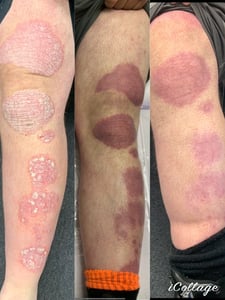Why do wounds on the lower leg take longer to heal?
If you have ever grazed your shin on the coffee table or had surgery to remove a skin cancer on your lower leg, you might have noticed that the wound seems to take longer to heal. Let’s look at why this is true, and what you can do to speed up your recovery time if you have skin cancer (or any other wound) on your lower leg.
Why do lower leg injuries take longer to heal?
Healing comes down to blood circulation. Your heart pumps blood throughout your body, delivering essential nutrients and working to heal everything from small scratches to larger surgical wounds. The further your blood travels from your heart, the more help it needs from your muscles to keep flowing. The older we get, the poorer our circulatory systems can become.
Improving blood flow to the lower legs (and therefore boosting the healing process) can be as simple as standing up and moving around rather than sitting for long periods of time; wearing compression socks; and elevating your feet where possible.
Skin cancers on the lower leg
Unfortunately, some people delay getting treatment for skin cancers found on their lower legs because the area can take longer to heal. This sometimes means that the skin cancer grows larger or more invasive, resulting in an even bigger surgical treatment that involves more time, risks and cost. (Sometimes, surgery could have been avoided altogether if the skin cancer had been treated early!)
How can lower leg wounds heal faster?
LED light therapy is recommended to enhance outcomes after skin cancer procedures or as a stand-alone treatment to optimise overall skin health. It is a safe, natural way to speed up the skin’s healing process!
People recovering from skin injuries, burns or surgical procedures experience less pain and inflammation, with fast healing and better scarring results, and no side effects.
LED light therapy is very versatile and can be used for:
|
|
-%20Pic%203%20is%20week%202-%20Pic%204%20is%20week3-%20The%20patient%20was%20treated%20for%203%20weeks%2c%20twice%20p-3.jpeg?width=300&name=First%20two%20pics%20were%20taken%20on%20the%20same%20day%20before%20and%20after%20LED%20(week%201)-%20Pic%203%20is%20week%202-%20Pic%204%20is%20week3-%20The%20patient%20was%20treated%20for%203%20weeks%2c%20twice%20p-3.jpeg) |
 |
LED light therapy is available at select locations at National Skin Cancer Centres.
